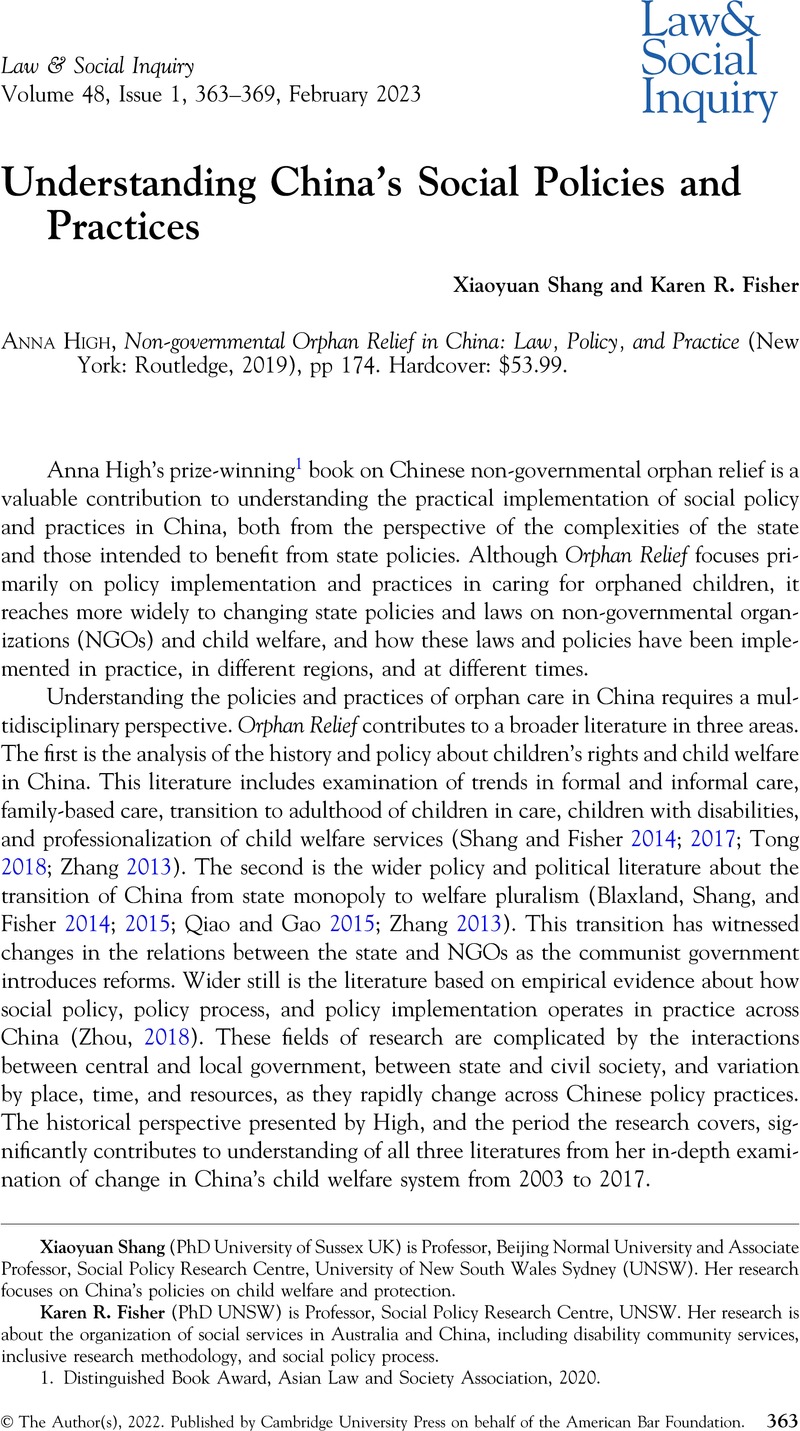No CrossRef data available.
Article contents
Understanding China’s Social Policies and Practices
Review products
Anna High, Non-governmental Orphan Relief in China: Law, Policy, and Practice (New York: Routledge, 2019), pp 174. Hardcover: $53.99.
Published online by Cambridge University Press: 02 December 2022
Abstract
An abstract is not available for this content so a preview has been provided. Please use the Get access link above for information on how to access this content.

- Type
- International Book Essays
- Information
- Copyright
- © The Author(s), 2022. Published by Cambridge University Press on behalf of the American Bar Foundation
Footnotes
Her research focuses on China’s policies on child welfare and protection.
Her research is about the organization of social services in Australia and China, including disability community services, inclusive research methodology, and social policy process.
References
Blaxland, Megan, Shang, Xiaoyuan, and Fisher, Karen R.. “People Oriented: A New Stage of Social Welfare Development in China.” Journal of Social Service Research 40, no. 4 (2014): 508–19.CrossRefGoogle Scholar
Blaxland, Megan, Shang, Xiaoyuan, and Fisher, Karen R.. “Transitional and Developmental Challenges for Chinese Social Policy.” Asian Social Work and Policy Review 9, no. 1 (2015): 1–2.CrossRefGoogle Scholar
Fisher, Karen R., Shang, Xiaoyuan, and Xie, Jiawen. “Global South-North Partnerships: Inter-cultural Methodologies in Disability Research.” In Disability in the Global South: The Critical Handbook. Edited by Grech, Shaun and Soldatic, Karen, 567–82. Cham, Switzerland: Springer, 2016.CrossRefGoogle Scholar
Howell, Jude, Shang, Xiaoyuan, and Fisher, Karen R.. NGOs and Accountability in China: Child Welfare Organisations. Cham, Switzerland: Palgrave Macmillan, 2018.Google Scholar
Human Rights Watch. Death By Default: A Policy of Fatal Neglect in China’s State Orphanages (Jan. 1, 1996).Google Scholar
Ministry of Civil Affairs (China). “Social Service Statistical Bulletin 2010.” https://www.mca.gov.cn/article/sj/tjgb/201107/201107151705659.shtml.Google Scholar
Ministry of Civil Affairs (China). “Civil Affairs Statistical Bulletin 2020.” https://images3.mca.gov.cn/www2017/file/202109/1631265147970.pdf.Google Scholar
Qiao, D., and Gao, K.. Cooperation Between Governments and Social Organizations: Models, Mechanisms and Strategies. Beijing: Huaxia Press, 2015.Google Scholar
Shang, Xiaoyuan. Impacts and Transition: The Development of China’s Civil Society Organizations. China Social Science Press, 2006.Google Scholar
Shang, Xiaoyuan, and Fisher, Karen R.. Caring for Orphaned Children in China. Lanham, MD: Lexington Books, 2014.Google Scholar
Shang, Xiaoyuan, and Fisher, Karen R.. Young People Leaving State Care in China. UK: Policy Press, 2017.Google Scholar
Shang, Xiaoyuan, and Wu, Xiaoming. “Protecting Children Under Financial Constraints: ‘Foster Mother Villages’ in Datong.” Journal of Social Policy 32, no. 4 (2003): 549–70.CrossRefGoogle Scholar
Shang, Xiaoyuan, Wu, Xiaoming, and Wu, Yue. “Welfare Provision to Vulnerable Children: The Missing Role of the State.” The China Quarterly 181 (2005): 122–36.Google Scholar
Tong, X. “Building a Child Welfare System from the Perspective of the State Guardianship.” Journal of Chinese Youth Social Science 2 (2018): 102–10.Google Scholar
Net, Xinhua. “Four Categories of Social Organizations Can Be Registered Directly Without Supervising Organizations in Beijing” (Apr. 7, 2011). http://news.sohu.com/20110407/n280172771.shtml.Google Scholar
Zhang, X. “A Literature Review of Foster Care for Orphaned and Disabled Children.” Reform and Opening-Up 17 (2013): 71–72.Google Scholar
Zhou, Xueguang. The Logic of Chinese State Governance: An Organizational Study. Beijing: Joint Publishing, 2018.Google Scholar


